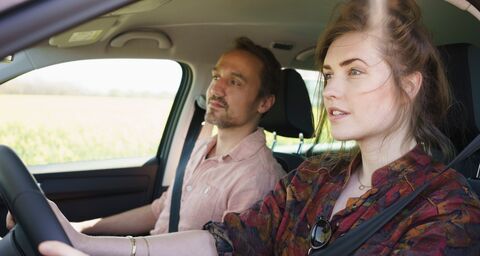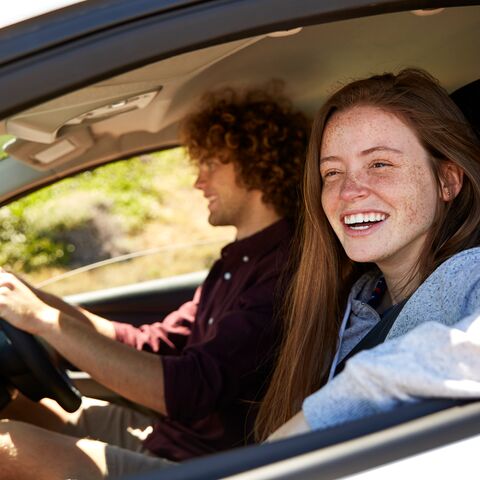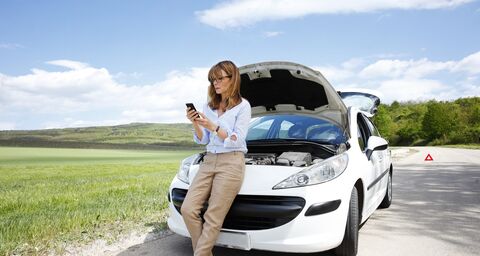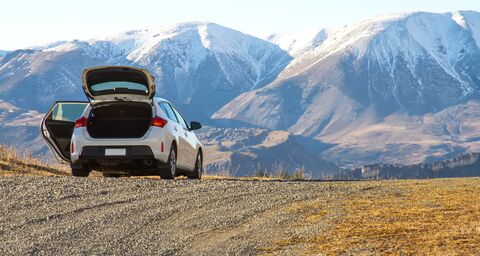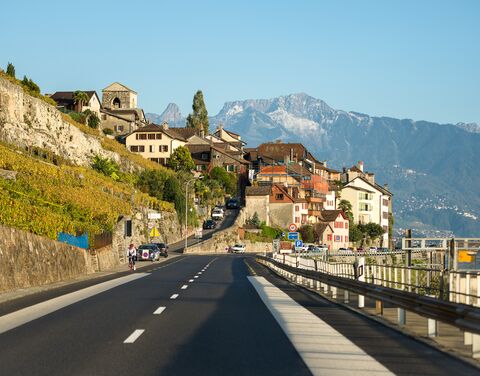
Traffic rules: what’s allowed on Swiss roads, and what isn’t?
If you passed your driving test a long time ago and aren't quite as familiar with the old and new rules of the road as you used to be, our blog is sure to answer many of your questions about driving in Switzerland.
When am I allowed to use the shoulder of a Swiss highway?
The shoulder, also known as the emergency lane, is for emergency use only. If there's no emergency, you're only allowed to stop at signposted parking lots and rest areas.
Do I need to carry my original driver's license and vehicle registration document with me, or are copies OK?
In Switzerland, you must always have your original driver's license and registration document in the vehicle with you, otherwise you risk a CHF 20 fine.
How much do you have to pay for parking violations in Switzerland?
Ordinary fines for parking violations vary and generally range from CHF 40 to CHF 120. The police differ here between the severity of the impediment to other road users and the duration of illegal parking.
For example, parking on a no-parking line for an hour or more costs CHF 120, while parking violations outside of town for up to two hours costs “only” CHF 40.
Is there any grace period for exceeding the parking time?
No, the law does not provide for any grace period.
What consequences should I expect if I park on private property where there are no judicial parking bans?
Although unauthorized parking on private property is not punishable by law, it is illegal because third-party property is being encroached upon. For this reason, the property owner can require you to move your vehicle. If that is not possible, they can have your vehicle towed. In this case, the response must be proportionate.
However, the property owner is not allowed to block your vehicle. That would be coercion, which is punishable.
In which cases can I have a charge brought against me for illegal parking?
If a “Gerichtliches Verbot” (judicial ban) is put up on the private property, then unauthorized parking can be punished by a fine or criminal charges.
Am I allowed to join a parade of cars?
Parades, for example after a soccer match or a wedding, aren't banned as such, but they can lead to various charges:
- causing a disturbance, e.g. by sounding your horn or driving back and forth unnecessarily. As a rule, causing avoidable noise carries a fine of CHF 200 to 300.
- failing to secure passengers adequately, e.g. if they lean out of windows and wave flags
Do I have to have a warning triangle with me at all times?
Your warning triangle must be in the vehicle at all times and must be within easy reach.
How do I set my parking disc correctly to make sure I don't get fined?
The arrow on the parking disc must point to the next half-hour marker after the time you actually parked. In a car, the disc must be placed behind the windscreen in a position where it's easily visible. For other vehicles, it must simply be placed where it can easily be seen.
Using a phone behind the wheel: what's allowed, what isn't?
Car drivers must focus their attention on the road and should not be distracted by “communication systems”. Making a call on a cell phone while driving normally incurs an on-the-spot fine of CHF 100. You are allowed to hold your phone in your hand, but you're committing a violation as soon as you start looking at it or texting. You could end up with a fine or even have your license taken away. As a general rule, you should keep your phone out of reach while driving.
Air fresheners on rear-view mirrors
Many drivers hang their coronavirus protective masks from their rear-view mirrors. Maybe in the hope that the masks won’t get dirty there or be forgotten during the next shopping trip. However, this habit violates traffic law: the driver must have a full and unobstructed 180° view ahead. No objects that could restrict the view may be attached in front of the windshield.
For this reason, air refresheners – just like football club pennants or face masks – cannot be attached to the rear-view mirror. At worst, you could even fail to see someone and injure them. A violation is normally prosecuted with a fine, but a warning or a suspension of your driver’s license is also possible.
In a traffic jam, am I allowed to pass stationary cars on the right?
In short, you're allowed to use the right-hand lane to drive past other vehicles, but not to overtake them. Since the start of 2021, you're allowed to pass on the right if there's slow-moving traffic, a traffic jam or an accident in the left-hand or center lane. This is intended to keep the traffic flowing as much as possible. Overtaking on the right, i.e. moving into the right-hand lane to pass and then moving back to the left, is still illegal. If you're caught breaking this rule, you can expect to be fined CHF 250.
I always start to panic a little when I hear sirens. What happens if I don't move to the side in time?
In slow-moving traffic or a traffic jam, drivers must leave space for the emergency services in case they need to reach the site of an accident. This means creating a gap between the left-hand and right-hand lanes on a two-lane highway or between the left-hand and center lanes on a three-lane highway. You must never use the shoulder for this purpose. You can be fined if you fail to leave space.
Can my dog travel in the footwell of my car?
Animals are regarded as cargo and must be secured accordingly. A dog might suddenly jump up onto its owner's lap, and that can be dangerous. Dogs should therefore travel in a dog box or be secured using a special safety belt.
Does a tractor holding up a queue of cars have to let me past?
Yes. Outside of built-up areas, slow-moving motor vehicles have to make it easy for faster ones to pass and should pull over to the side of the road where possible.
What sort of fines do tuning fans have to expect?
If a tuned vehicle has a part that does not comply with legal provisions, then the keeper and driver are at risk of a fine of CHF 200 to 400. What’s more annoying than the fine is that the criminal authorities can confiscate the vehicle as evidence if there is the suspicion that the vehicle is not in a condition that is in accordance with the law. If you create an unnecessary amount of noise with your tuned car then you must also expect a fine.
Are daytime running lights OK in a tunnel?
No, you must always turn on your headlights on low beam in a tunnel.
Do I always have to observe the "zipper" principle on the highway?
As of January 2021, the zipper principle is mandatory wherever two lanes merge into one on the highway. This means that each vehicle traveling in the free lane has to leave room for one vehicle traveling in the blocked lane to merge. This new rule is intended to prevent traffic from merging into the free lane too soon, which can cause a traffic jam. You can be fined for failing to observe the zipper principle.
What happens if I don't wear a safety belt?
Failing to wear a safety belt can result in a CHF 60 fine. Be warned: your insurer might reduce the amount it pays out if you have an accident while not wearing a safety belt.
What are the consequences if I tailgate on the motorway?
In heavy traffic, cars are squeezed on the highway together with numerous fellow sufferers in the evening rush hour. In these situations however, caution is required not only for safety reasons, but also because of the legal consequences. You must always leave a safety gap between yourself and the vehicle in front.
For many years, the Federal Supreme Court has been applying the “half the speed” approach which corresponds to a two-second gap. If drivers do not adhere to this gap, then provided they have no previous offenses, they are at risk of a fine and confiscation of license for at least one month. If the gap is actually less 0.6 seconds, the penalty is imprisonment or a fine, including a criminal record and confiscation of license for at least three months. You shouldn’t get too close to a car crawling along in the left-hand lane either.
Can I fit spiked tires to my car in the winter?
You're not allowed to drive with spikes on highways and expressways. Otherwise, spikes are only permitted on motor vehicles with a gross weight of up to 7.5 tons, motorcycles, lightweight and small cars, three-wheeled vehicles, and trailers attached to them, and they can only be used in snow and ice between November 1 and April 30.
My car was towed away from private property. What do I have to watch out for when it comes to the cost?
The property owner is entitled to charge the owner of the vehicle for the cost of towing it. Towing firms normally take care of this themselves. The tow charge is often a sore point. You should pay the bill if you want to avoid facing debt collection proceedings.
Am I allowed to use a road bearing the sign "Access for residents only" if I'm visiting someone?
Yes, people visiting residents are allowed access as well.
Am I allowed to use a navigation device with a radar detector function under Swiss law?
No, radar detectors are banned in Switzerland. You can be fined for using one.
How clearly do pedestrians have to indicate that they want to use a pedestrian crossing?
Pedestrians are not obligated to indicate that they want to cross the road, but they are supposed to take care when doing so and not just step out unexpectedly. They have the right of way at a pedestrian crossing, except when a car is so close that it can't possibly stop in time.
Drivers have to take special care when approaching a pedestrian crossing.
A bus driver is indicating left and wants to pull out of the bus stop. What do I have to do?
If a bus driver wants to pull out of a stop in a built-up area and uses the indicator, all vehicles coming up behind must slow down or stop to let the bus out.
I want to take a young person out for a driving lesson. What do I have to keep in mind?
The person accompanying a learner must be at least 23 years old and must have held a category B driver's license for a least three years and completed the probation period. Both the learner and the accompanying person must refrain from drinking alcohol before the lesson. The accompanying person must be able to reach the handbrake easily at all times.
You need to be particularly careful these days where the handbrake's concerned because conventional handbrakes are increasingly being replaced by electric parking brakes operated by a button or switch. Before accompanying someone on a driving lesson, you should always check that you can easily reach this button or switch. It isn't always on the center console. Some manufacturers put it somewhere else to save space. If you can't reach it, for example because it's to the left of the steering wheel, you're breaking the law.
Tips for the accident statement
If the police do not attend the accident site, follow these recommendations to avoid any problems after an accident involving property damage:
- Fill in the details of the location and people involved carefully.
- Check all the relevant boxes under "Circumstances".
- The sketch is very important and must be as accurate as possible. Don't rush it.
- If one of the people involved admits responsibility, you should note this under "My remarks". Call the police if no one is prepared to take responsibility for the accident or if the situation is unclear.
- Collect further evidence wherever possible: photos of the damage, witness statements, etc.
What do I have to do after a road accident?
First of all, everyone involved must stop immediately and ensure that oncoming traffic is diverted around the accident site. If someone has been injured, first aid must be administered – and someone has to call the police. Those involved must wait for permission from the police before leaving the accident site.
If the accident has merely caused damage to property, the police don't necessarily have to come. As long as the damage concerns two motor vehicles, the drivers can reach an agreement between themselves. We recommend asking for an admission of responsibility in writing to avoid any insurance problems later on.
I hit another car while reversing in a parking lot. What do I have to do?
You must contact the owner of the damaged car immediately and provide him or her with your name and address. If you can't reach the owner, you have to call the police.
Is it enough to write down my contact details and slip them under the windshield wiper?
No. If you can't reach the owner of the damaged car, you have to call the police.
My car was rear-ended but not badly damaged. The other driver admitted responsibility, and I filled out an accident statement, but his liability insurance is refusing to pay out. What did I do wrong?
In principle, the injured party must prove that the other party was at fault following an accident that involved property damage. If the accident statement is too vague or the other party changes his or her opinion later on, the liability insurer will reject the claim due to lack of evidence. This means that you'll have to pay for the repairs out of your own pocket or claim on your accidental damage insurance, which is especially frustrating when it's clear who was at fault.
What happens if I don't report an accident?
Failing to report an accident to the police is against the law. You'll get a ticket if you flee the scene of an accident that resulted in property damage. Fleeing the scene when someone has been injured counts as a hit and run and can lead to a larger fine, a criminal record, and losing your license for at least three months.
It's important to remember that hitting a wild animal also counts as an accident resulting in property damage, so it must be reported to the police immediately.


